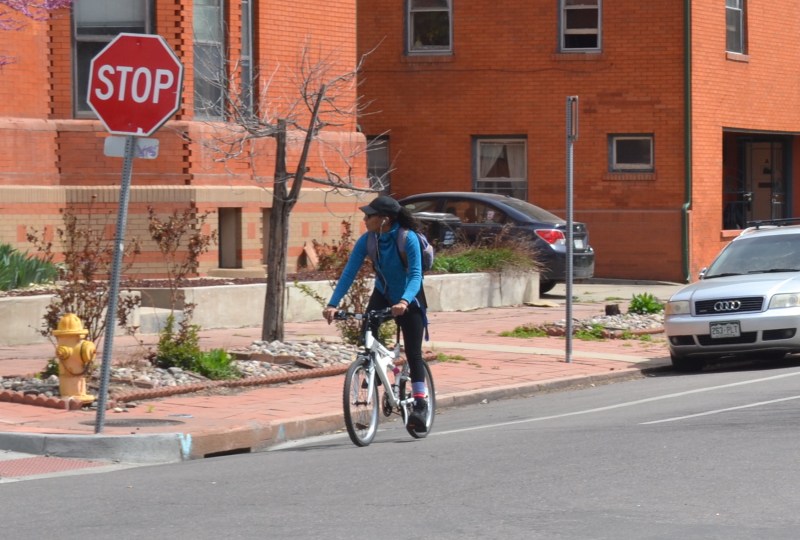Cyclists Can Roll Through Stop Signs in Thornton, a First in Denver Metro

A Denver suburb just approved a controversial safety plan that will allow cyclists to slow-roll through stops signs — a practice that studies show keeps cyclists safer than coming to a full stop.
The City of Thornton passed the measure in a 6-2 vote on Tuesday night. The so-called Idaho Stop, which earned its nickname after the state that adopted the practice in 1982, legalizes something most cyclists do already. Perhaps counterintuitively for non-cyclists, the Idaho law has been shown to reduce injuries, which is why advocates here call it the “Colorado safety stop.”
Bicycle advocates hope that other cities — including Denver — will soon follow Thornton’s lead. And they say the practice is often safer because when cyclists move into parts of the intersection where they are visible to drivers, they can better assess if they should continue or come to a complete stop.
“It’s safer for bicyclists to be visible and out in front of an intersection when they have the right of way,” said Jack Todd, a spokesman for Bicycle Colorado. He cited a study from the University of California, Berkeley. The researchers found that bicycle injuries declined 15 percent in the first year after Idaho adopted a similar rule statewide.
But not everyone buys the safety argument, including Adam Matkowsky, who is a police officer and one of the Thornton city council members who voted against the ordinance.
“I’m a bicyclist,” he told Streetsblog, adding that he commutes 20 miles from his home in Thornton to his job in Westminster. “I’m out there Zero Dark Thirty in the morning with my little blinking lights all over me and [drivers] still don’t see me. They don’t stop for me. They don’t yield for me.”
A police officer for 21-years, he says that his experience responding to bicycle crashes influences how he bikes. He comes to a complete stop at every stop sign, and he thinks others should, too.
“It’s just not worth it to me,” he said. “I just found [the ordinance] one big huge safety concern.”
But the University of California study points out that, compared to drivers, cyclists can see and hear what’s going on at intersections better than motorists.
“Bicycles and motor vehicles are fundamentally different machines,” Todd said. “We need to think about them differently in terms of the way that they’re governed on the road.”
Cyclists have been able to roll through stops in Idaho for decades, and Delaware adopted a similar rule in 2017. In Colorado, Aspen, Dillon, Breckenridge and all of Summit County had similar laws on the books. Last year, a state law passed that standardized how Colorado municipalities adopt such rules going forward.
For cyclists, forcing them to come to a complete stop kills their momentum. That takes more energy, requires more time and can lead to bikers falling. All of that discourages cycling, said Todd. And safety stop laws make biking more enjoyable, he says, which could help a city like Denver reach its goal of reducing the number road-clogging trips people take alone in private cars.
“Ultimately we view this as a way to get more people riding,” he said. “If people feel safer on their bikes, they’re more likely to do it. And and that is a way for Denver to meet its multi-modal goals.”
Even though riders in Thornton will soon be able to roll through intersections, Matkowsky said he doesn’t want to respond to more bike crashes.
“Just take an extra second to look,” he said. “Just be careful.”
Correction: A previous version of this story said that Colorado municipalities that had enacted safety stop ordinances were not valid until last year when the state law passed. The story was corrected to reflect that those ordinances were valid.
Better walking. Better biking. Better transit. Support the mission of Streetsblog Denver. Give $5 per month.


